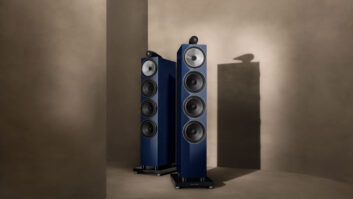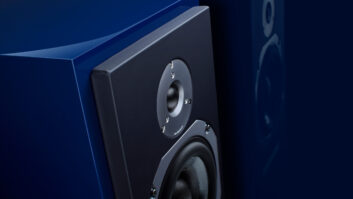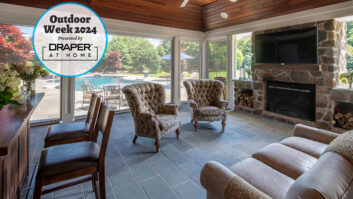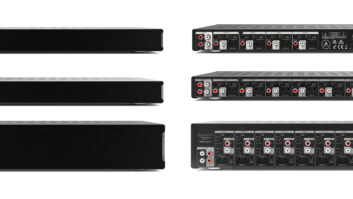One thing is for certain: bass sells. Nothing impresses your customers more than tight, clean and dynamic low frequency. You could say that bass adds the “bottom line” of home theaters. Unfortunately, bass is in peril.
There are an increasing number of ways to mangle bass performance these days, and because Murphy is always at work, there’s a really good chance it will get mangled somewhere along the line.
Before I describe the dangers of bass and the ways to deal with them, let me first outline what I consider to be good bass:
Extended in-room response down to 20Hz
Consistent low-frequency character for all channels
Output level capability of at least 105dB SPL (preferably 110dB) for bass in any channel
No audible distortion
Resonance-free character for smooth response and “tight” time character
No variations from seat to seat in a multi-seat listening room (theater or music application)
No localization of bass sources
Smooth overload character (since virtually nothing out there can play everything recording engineers “mix up” without overloading at some point).
These are the things that, to me, quantify what the average purse-string holder out there will hear as impressive bass.
Now, for the perils that will mess with your bass:
Room Acoustic Standing Waves (a.k.a. Room Modes). Standing waves are one of the biggest bass killers. Take a perfectly good subwoofer or full-range speaker, put it in a room, and what do you get? Usually, you get a speaker that doesn’t sound so perfectly good! The bass becomes irregular, with emphasis at some frequencies and losses at others. Also, the bass becomes muddy and resonant, hanging in the room way too long at the prime resonant frequencies. Dealing with standing waves takes a systematic and cautious five-step approach: (1) Room dimensions should be such that resonant frequencies don’t multiply on the three axes. (2) Room construction should be such that the walls are flexible or absorptive at low frequencies. (3) The subwoofers should be placed so that they don’t excite the resonances. (4) The seats should be located where the resonances are less audible. (5) The remaining response errors should be equalized to eliminate peaks in the response.
If you want to configure a home theater’s bass reproduction for the best interaction with standing waves, you should employ bass management, which feeds all of the bass, as a summed mono signal, from the main channels into subwoofers. You can then place the subs for limited interaction with standing waves, and the bass will be consistent from channel to channel. Typically, the best crossover frequency is around 80 Hz, because that is where most of the nasty room resonances start. It is also a sufficiently low enough frequency so that you won’t be able to localize the subs.
The DVD-Audio and SACD Connection Conundrum. As most custom installers probably already know by now, the typical connection scheme for a DVD-A or SACD player is six analog interconnects run to a surround processor. The problem is that, if you want to use bass management as advised above, you may be out of luck, because many players don’t include bass management and most processors’ six-channel analog inputs don’t either. So, you play a Dolby Digital or DTS signal fed digitally from the player, and everything is okay. Then, you switch to the six-channel analog input, and there’s no low bass, because the bass from the main channels of the music mix or film soundtrack isn’t finding its way to your subwoofers.
How do you know if you have this problem? Try reading through your DVD player and surround processor’s specifications, block diagrams and owner’s manuals for information on bass management parameters. If these documents don’t help, you can try calling the product managers at the manufacturers’ home offices to see if they can provide further info. Ultimately, you can test the signal flow by putting a test DVD or DVD-A into your player, running the signal through the six-channel analog path into your surround processor and measuring the response at the processor’s outputs with a spectrum analyzer (or by ear if you have no test gear). Some test discs have a center-channel bass signal that should mainly end up in the subwoofer if bass management is set properly. The Chesky DVD-A test disc, The Ultimate Surround Sampler & 5.1 Set-Up Disc (CHDVD221) is a good source for test signals. It features Dolby Digital 5.1 and PPCM 5.1 test signals as well as 96 kHz 2-channel stereo LPCM. There are also bass management, speaker phase, frequency response and delay alignment tests, plus eight music selections from the Chesky catalog.
Surround Processors with Adjustable LFE Levels. Some processors allow you to set the ratio of the LFE (Low-Frequency Effects) signal to the rest of the bass sent to the subwoofers. Why? I can’t think of a good reason, because production standards call for the LFE level to be encoded +10dB compared to the main channels. (I’ll bet adjustable LFE level is a feature that manufacturers put in their products because of competition…) If a processor’s LFE level control is set improperly, the bass signals placed in the LFE channel by a sound designer or recording engineer may play back too low or too high, thereby completely messing with the delicate tonal balance of your system. To check that the LFE level is set correctly, just verify that the LFE level control is not set to attenuate the LFE channel signal that is mixed into the subwoofer feed. Again, you can verify correct levels by using one the various test DVDs on the market.
Surround Processors with Built-in Subwoofer Output Limiters. Many processors incorporate built-in adjustable limiter functions that are often referred to as bass peak level limiters. This function is nice to have if you use passive subwoofers, or if the limiters built into your active subwoofers generate audible distortion side effects. If you don’t check your processor’s limiter, it might be set too low, meaning that peak bass signals are never allowed out of your processor. That’s a bad thing. Remember to go into your processor’s setup menu and either turn the limiter off, or engage it at the level where your subwoofer starts to misbehave.
Surround Processors with Multiple Subwoofer Outputs. Some newer processors offer multiple subwoofer outputs. I don’t consider this a useful feature as 99 percent of the time all you need is a subwoofer output that contains the sum of the LFE signal and the low-frequency portions of all the main channels. Nevertheless, the market keeps pushing forward and demanding more features. Just make sure you have correctly configured all those subwoofer outputs, or else your bass may be leaking out the wrong port (so to speak).
Subwoofers with Multiple Bass Inputs. Like I just explained, the best way to manage your bass signals is to create a collection of LFE plus low frequencies from the main channels, and then ship it to the subwoofer(s). The surround processor should perform this function; there is no reason to duplicate it elsewhere in your system. Sure, things will sound different as you start adding more signal paths between the processor and the subwoofer, but different may be wrong, and may result in inconsistent bass or just too much bass.
Production Uncertainties. This is a really tough problem. It used to be that all film DVDs were recorded and mastered under standardized conditions. The bass in monitoring rooms was set at a predictable level, so all you had to do was create a listening environment calibrated to the same level. Well, it now seems that some folks in the production community have decided to master DVDs their way, using mastering rooms with inconsistent bass levels. In some cases, mastering engineers are altering the bass balance of a soundtrack for a DVD release remix. It gets even worse in the world of multi-channel music mastering, where bass management is often misunderstood and improperly set in the monitoring room. As a result of all of this confusion, you end up with wild variations in bass levels from disc to disc. I prefer not having to readjust the bottom end of my system for each disc in a demonstration. Unfortunately, those days may be numbered.
You can’t do anything about production problems other than choosing your demo material carefully and hoping that your customers won’t complain about the bass variations in their systems once they start running them. Oh, I guess you could write letters to the editors of relevant magazines, and also call the DVD companies to complain.
My intent here is to reassure you that you are not crazy. Those wild bass variations from system to system and from disc to disc really do exist, and are not just a figment your imagination. Further psychoanalysis might reveal that you are, in fact, a bit crazy; you have to be to work in this business every day! I can’t help you regain your sanity, but for the bass problem I say to be vigilant and understand the theory and practice of bass standing waves, bass management and low-frequency production standards. Two Advil will also make you feel better.







